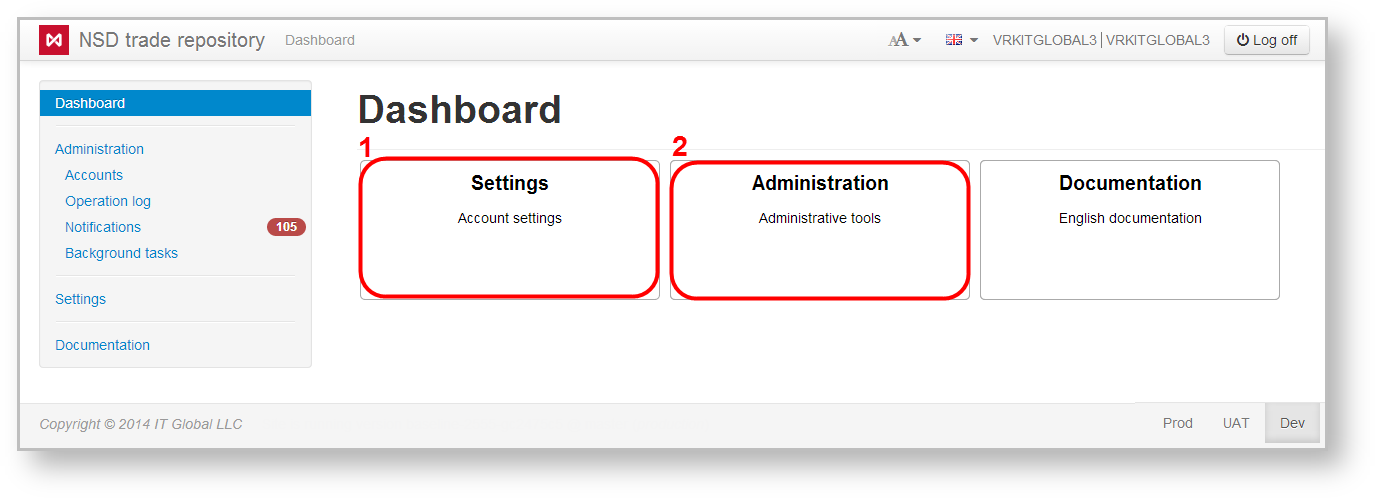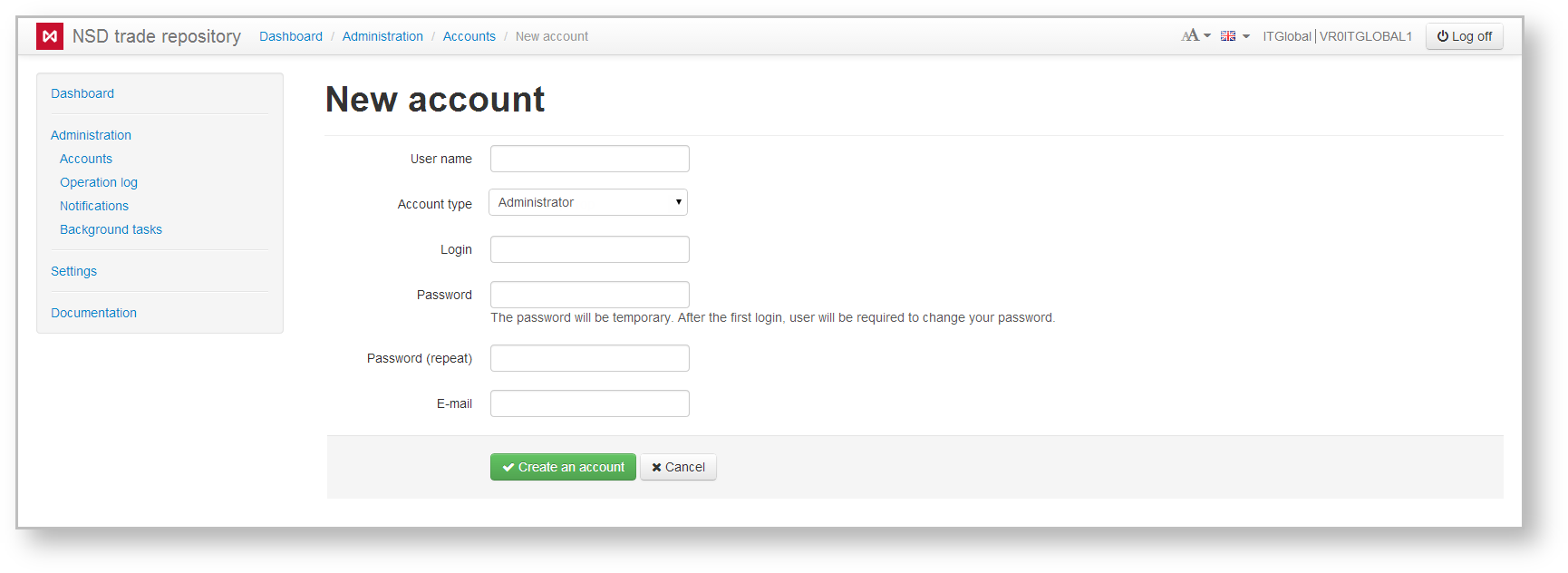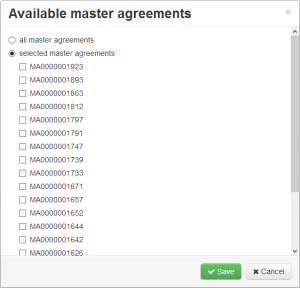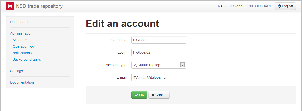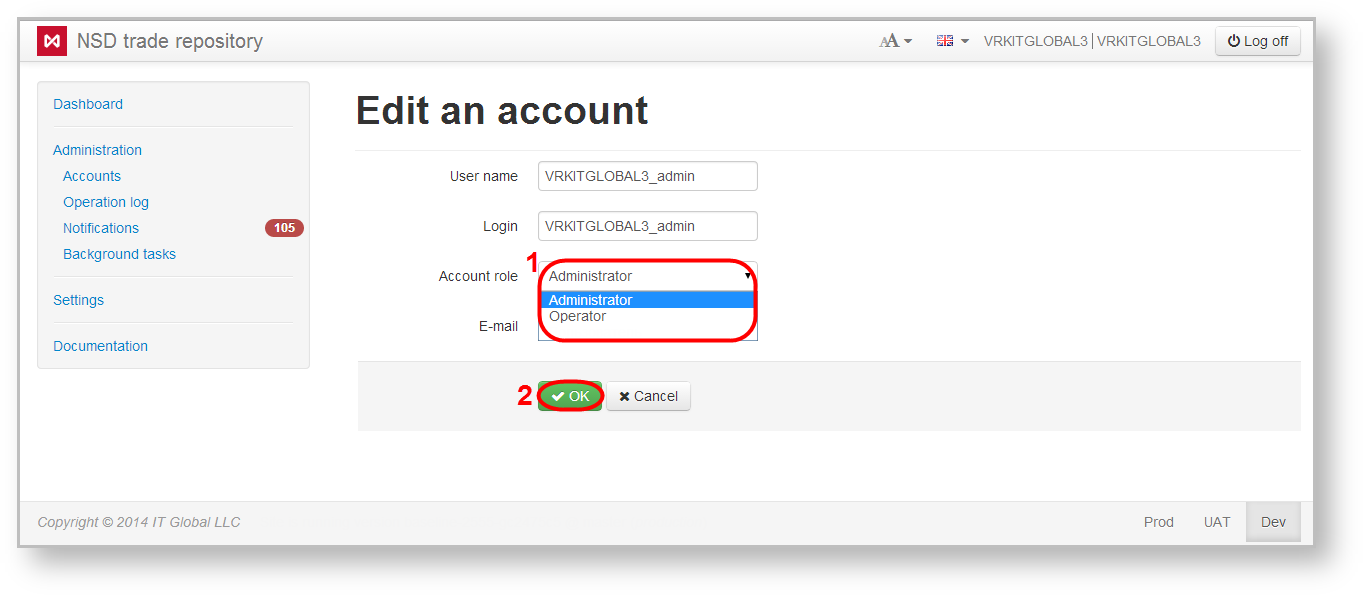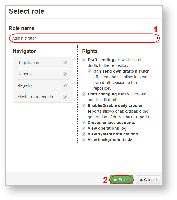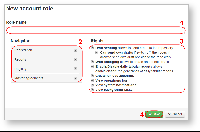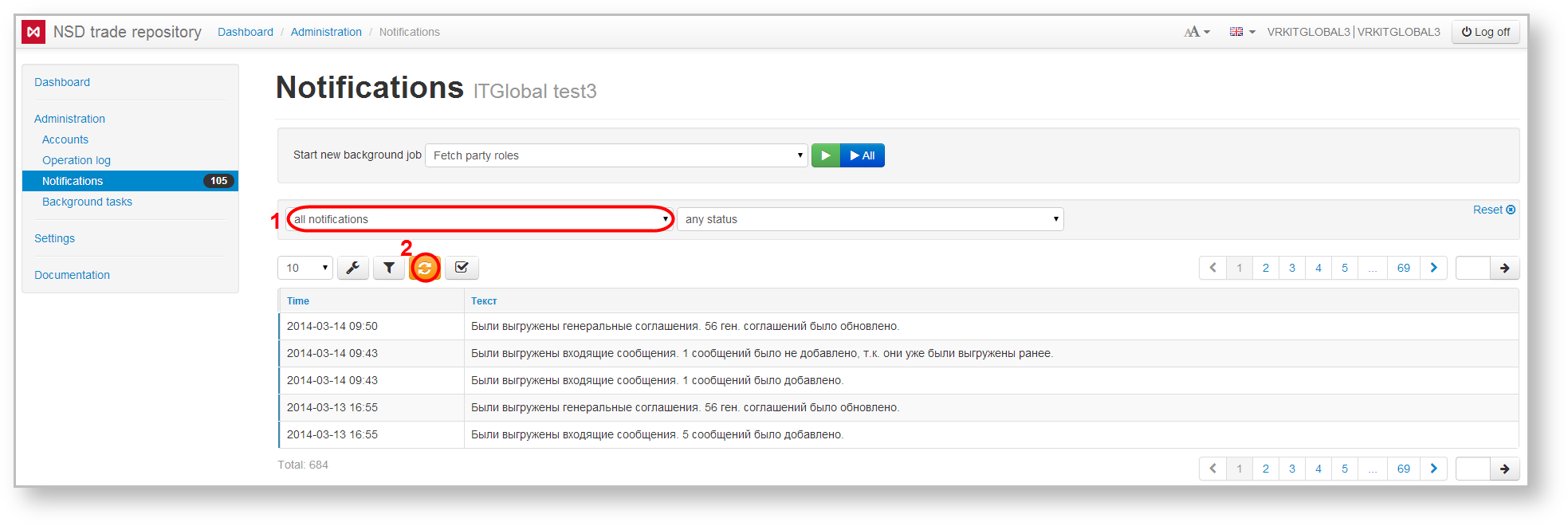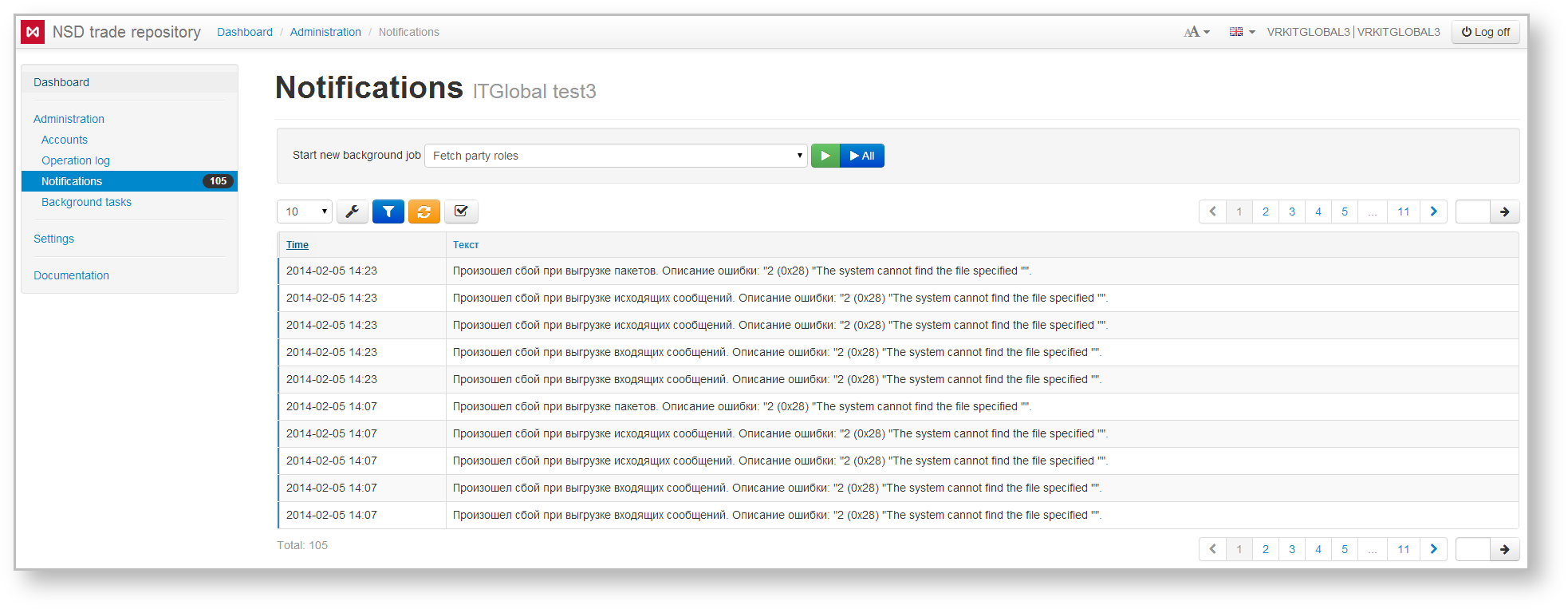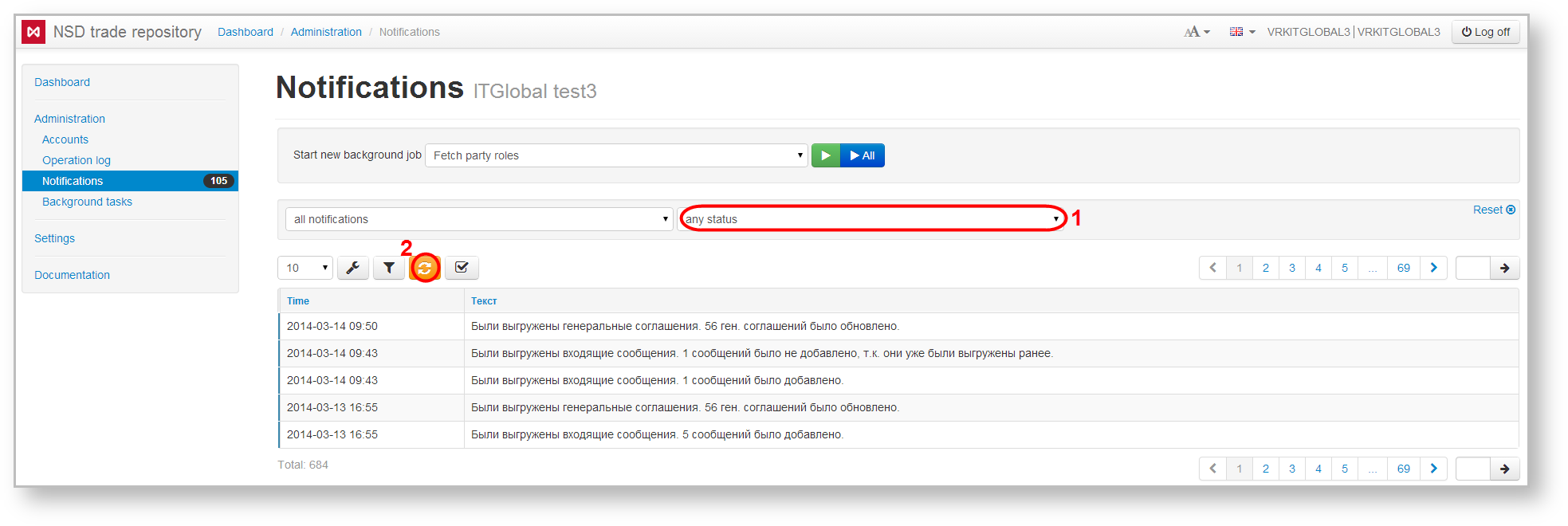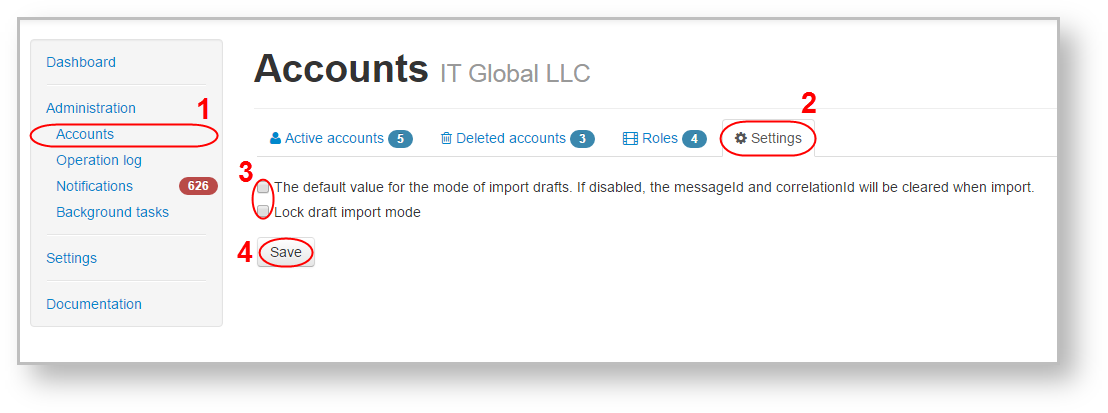Page History
| Section | |||||||||||||||
|---|---|---|---|---|---|---|---|---|---|---|---|---|---|---|---|
|
Accounts
Setting up accounts includes:
- adding an account;
- editing accounts;
- deleting accounts;
- creating additional accounts.
To set up an account, it is necessary to select Accounts in the sidebar menu. This form contains the following tabs:
| Anchor | ||||
|---|---|---|---|---|
|
The tab Active accounts (fig. 2) displays information about the current system users.
...
- User name;
- Login;
- Account role;
- E-mail address;
- Creation Date;
- Last Login date.
Adding accounts
| Anchor | ||||
|---|---|---|---|---|
|
Fig. 3 – adding a new user
Fill in this form with account parameters:
- User name;
- Account type ( administrator, operator or an another role);
- Login and password for authorization;
- E-mail for e-mail notifications about new messages in the repository. E-mail address are set up using the button. The buttons are described in table 1.
Then you need to click button. The new account will be displayed in the list of active accounts. During the first attempt of authentication in the system the user will need to change password created by the technical administrator for information security. After that the user can continue to work in the system.
Editing accounts
| Anchor | ||||
|---|---|---|---|---|
|
Fig. 4 – toolbar
The toolbar buttons are described in Table 1.Anchor Таблица1 Таблица1
Table 1 – Toolbar buttons
| Button | Description | Form | ||||||
|---|---|---|---|---|---|---|---|---|
Clicking on the button the user is taken to the access right restriction form In this form, the technical administrator can create a set of master agreements for the operator with access to the information regarding these agreements. For example, if the registration of contracts under a certain master agreement is delegated to a certain employee, and he should not have access to information regarding any other agreements, the only corresponding agreement should be marked by checkbox | ||||||||
| Clicking on button the user is taken to the account editing form The account editing form allows the administrator to change name, login name, account type and email address | |||||||
Clicking on button opens an account password change form After changing the password the technical administrator must deliver the new password to the user. When the user first logs into the Web-client, he must change the password to be able to further work in the system | ||||||||
| Clicking on this button the user is taken to the delete account confirmation form. Deleted user accounts are displayed in the Deleted accounts tab |
Сhanging roles
There are two ways to change user roles.
The first way: click the button. As a result, the account editing form will open. In this form you need to select a value in the Account type drop-down list (fig. 5.1) and click OK button to save it (fig. 5.2).
Fig. 5 – changing roles
The second way:
check the appropriate checkboxes at the accounts to be changed (fig. 6.1). As a result, the Edit role button will be shown;
Fig. 6 – Role tab
click the Edit role button (fig. 6.2);
choose the necessary role (fig. 7.1);
Fig. 7 – changing the account type
click the Select button (fig. 7.3) to apply settings.
| Anchor | ||||
|---|---|---|---|---|
|
The tab Deleted accounts displays a list of deleted accounts. You can restore a deleted account by clicking the button, which opens on hovering the mouse over the row in the table. The restored accounts are displayed in the Active accounts tab (fig. 8).
Fig. 8 – Deleted accounts tab
| Anchor | ||||
|---|---|---|---|---|
|
By default in Web-client has three types of accounts (technical administrator, administrator, operator). The list of available roles is displayed in the Role tab (fig. 9).
Fig. 9 – Role tab
If the the parameters of the basic roles are not suitable for solving problems, you can create custom roles and specify access rights for them. To do this:
- click on the button. As a result, the New role window will appear (fig. 10.1);
Fig. 10 – new account role - enter the role name (fig. 10.1);
specify forms and rights available for the role by checking the appropriate checkboxes (fig. 10.2 and 10.3);
Tip To use tabular reports you need to specify Reports (fig. 11.1) form and Enable/Disable daily tabular reports right (fig. 11.2) by checking the appropriate checkboxes
- click the Save button (fig. 10.4).
As a result, a new role will be created. You can change access rights of the role using the button in the pop-up toolbar. Clicking the button opens a window, where you will need to enter the required values and click the Save button.
To delete a custom role you need to click on the button. If the Web-client has an active account with this role, the button will be unavailable.
| Info |
|---|
You cannot delete or edit the basic roles. |
To download role list click button above the table. As a result, the table with the following data will be downloaded to a computer in the Excel format (.xlsx).
Operations log
The operations log records all events that occurred in the system during the user experience. Operation logs are used to determine the source of current system malfunctions, as well as to prevent possible problems. The information in the log (fig. 11) is displayed in the form of a table that contains:
- operation number;
- date and time;
- user name;
- category and the name of the operation.
Fig. 11 – operations log
Each record in the table can be opened for detailed view (fig. 12) with the button that pops up when hovering the mouse over the table row.
By default, the log displays all operations. Certain operations (for example, performed by an administrator) can be viewed using filters. To apply filters, to open the settings bar by clicking on button and define the required parameters (fig. 13).
Fig. 13 – setting up filters
Filters implemented in the Web-client are described in Table 2.
Table 2 – Filters for configuring the operations log
Filter number | Filter name | Description |
|---|---|---|
| 2 | By accounts | The filter is used to display operations that were performed under a specific account |
| By category | The filter is used to display operations of the following categories:
|
| 4 | Entries per page | The filter is used to set the number of transactions to be displayed on a page |
| 5 | Section | The filter is used to display Archive that contains operations performed 7 days ago |
Operations corresponding to your search criteria will be displayed in the table.
Operations log can be downloaded to a computer in the Excel format (version excel 2007/2010) by clicking the button above the table. If the filter is not configured, the entire log will be downloaded. If set filter settings, the specific events will be downloaded.
Notifications
The Notifications form (fig. 14) displays a list of system transactions and errors that occurred during their performance. The notification contains time (fig. 14.1) and text of the operation (fig. 14.2). Notifications are displayed in order of receipt. New incoming messages are displayed at the top of the table.
Fig. 14 – Notifications form
In this form, the following categories of notifications are available for viewing:
- export of the BRA roles;
- export of master agreements;
- export of outgoing messages;
- export of incoming messages;
- export of contracts;
- export of TransfersAndExecution;
export of contract statuses;
export of packages from the repository.
To start all operations click (fig. 15.1). To start a specific category of tasks you need to select a category from the drop-down list (figure 15.2) and click (fig. 15.3).
Fig. 15 – select the notification category
The Notifications form displays not only informational messages, but also system errors. To view them:
- сlick on the button;
- click on in the Display filed;
- select the type of notifications from the dropdown list (fig. 16.1);
- click on (see fig. 16.2).
Fig. 16 – select the notification type
Example of a system error messages is shown in fig. 17.
Figure 17 – system error notification
For user's convenience the viewed messages can be grouped under a separate category Read. To do this click on button in front of the necessary notifications. To see current and viewed notifications click on the drop-down list (Fig. 18.1), select the type of messages and click Show (Fig. 18.2).
Fig. 18 – select the type of notification
Background tasks
The Background tasks form contains a list of system messages about operations that are at the stage of execution. The following categories of tasks are available for viewing in this form:
- export of the BRA roles;
- export of master agreements;
- export of outgoing messages;
- export of incoming messages;
- export of contracts;
- export of TransfersAndExecution;
- export of contract statuses;
- export of packages from the repository.
Click to start all background tasks. To start a specific category click on the drop-down list and select a category, then click on button (fig. 19).
Fig. 19 – Background tasks form
This will display a list of tasks in the form of a table, where each row contains the time and the text of the task.
Import settings
To choose import mode go to Accounts→Settings and set checkbox:
- – cleared messageId and correlationId; – import drafts without changes;
- lock changing the Import mode;
Fig. 20 – settings form
To save changes click Save button. Settings will be applied for for all users.
